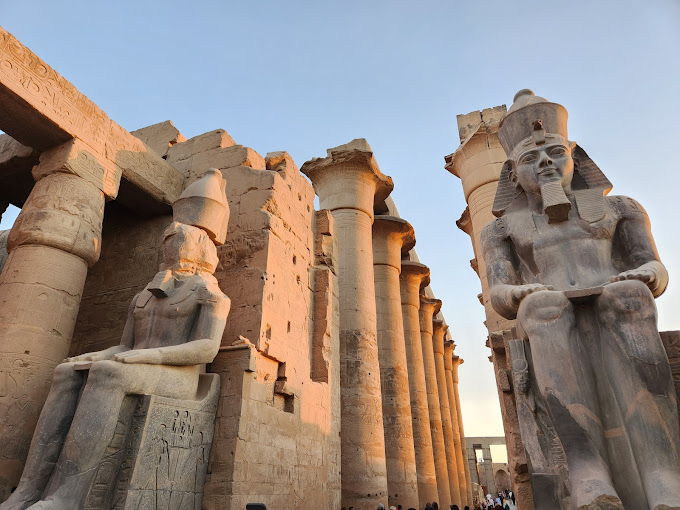Cultural, historical, adventure, and custom customized trips are just a few of the tours that Deluxe trips offer in Egypt and Jordan.

Standing in the very center of present-day Luxor (formerly Thebes), the Luxor Temple is one of Ancient Egypt's most famous monuments. Unlike other temples constructed to commemorate specific deities, Luxor Temple was commissioned more or less to celebrate the renewal of kingship and divine pharaonic right. Constructed around 1400 BCE under Amenhotep III and added on by Ramesses II, the temple is still a living testament to Egypt's glorious past.
The only one of its kind at Luxor Temple is that it was not dedicated to a god but to the ka (spirit) of the king. It was a focal point for the Opet Festival, which was celebrated annually, when statues of Amun, Mut, and Khonsu would be transported from Karnak Temple to Luxor Temple on the Nile River, symbolizing the heavenly union of the pharaoh with the gods.
Even Alexander the Great contributed to the temple with an inner shrine, testifying to its ongoing importance well into the Greco-Roman era.
Possibly the most dramatic feature of Luxor Temple itself is the Avenue of Sphinxes, a 2.7 km long avenue lined with hundreds of sphinxes connecting Luxor Temple and Karnak Temple. This sacred road was uncovered and partially restored in more recent times, adding yet another level to the site's sheer scale.
Pharaoh Ramesses II left his giant stamp on his monumental legacy by building the massive pylon at the temple entrance, which stands tall today with giant statues of the ruler. Two obelisks once stood here, but one of them now stands in Paris's Place de la Concorde. This contributes to Luxor Temple's representation of Egypt's global cultural heritage.
Architectural Wonders and Hidden Symbols
The design of the temple is a typical Egyptian design — a start with an open courtyard, followed by a hypostyle hall and inner sanctuaries. Walls are filled with hieroglyphs and carvings that depict scenes of rituals, war, and divine interactions.
Several symbols, including those of the lotus flower, ankhs, and solar disks, reinforce the theme of rebirth and eternal life, themes paramount to ancient Egyptian religion.
One of the unique but fascinating aspects of the Luxor Temple is the Abu El Haggag Mosque, which was built on the location of the destroyed ancient temple in the 13th century. It is still an active mosque today, showing the continuous utilization of the temple for over 3,000 years and the blending of ancient Egyptian and Islamic culture.
The best time to see Luxor Temple is in the evening or late afternoon, ideally when it is magnificently lit in the darkness of the night. Visiting during night hours is like experiencing the paranormal with the shadows playing on the ancient stones and hieroglyphics assuming a mystical shine.
Luxor Temple is an essential stop in most Egypt day tours, especially in Luxor and Nile cruise itineraries. Whether you’re a history lover, a spiritual seeker, or a photography enthusiast, the Luxor Temple offers a memorable and immersive experience.
While visiting Luxor Temple, be sure not to miss these nearby wonders:
Karnak Temple Complex
Valley of the Kings
Hatshepsut Temple
Luxor Museum
These sites together form what most people call "the world's greatest open-air museum."
The Luxor Temple is more than just another ancient ruin — it is the icon of Egypt's might, majesty, and unmatched architectural skill. A visit here offers more than history; it's a journey into the very core of pharaonic society.
If you’re planning an Egypt tour or Nile cruise, make sure Luxor Temple is on your must-visit list. Its magic continues to inspire travelers and scholars alike.
Discover now our answers to the most common questions that may come to your mind about tourism and trips to Egypt
Cultural, historical, adventure, and custom customized trips are just a few of the tours that Deluxe trips offer in Egypt and Jordan.
The Dead Sea, Petra in Jordan, the Pyramids of Giza, Luxor's historic temples, and many other famous sites can be expected to be explored with Deluxe Tours.
offer a hassle-free holiday, Deluxe Tours' packages generally include lodging, transport, meals, guided tours with experienced local experts, and entry fees to attractions.
Spring (March to May) and fall (September to November) offer the finest weather for sightseeing and outdoor activities, making those months the best times to visit Egypt and Jordan.
These two countries are close by, only a 1.5-hour flight apart, and when combined, offer a variety of distinctive experiences. We advise you to spend at least 12 days visiting both countries for a truly unforgettable experience
Combining the eclipse viewing with visits to historic sites like the Pyramids of Giza, the Valley of the Kings, and a Nile River cruise are highly recommended.
